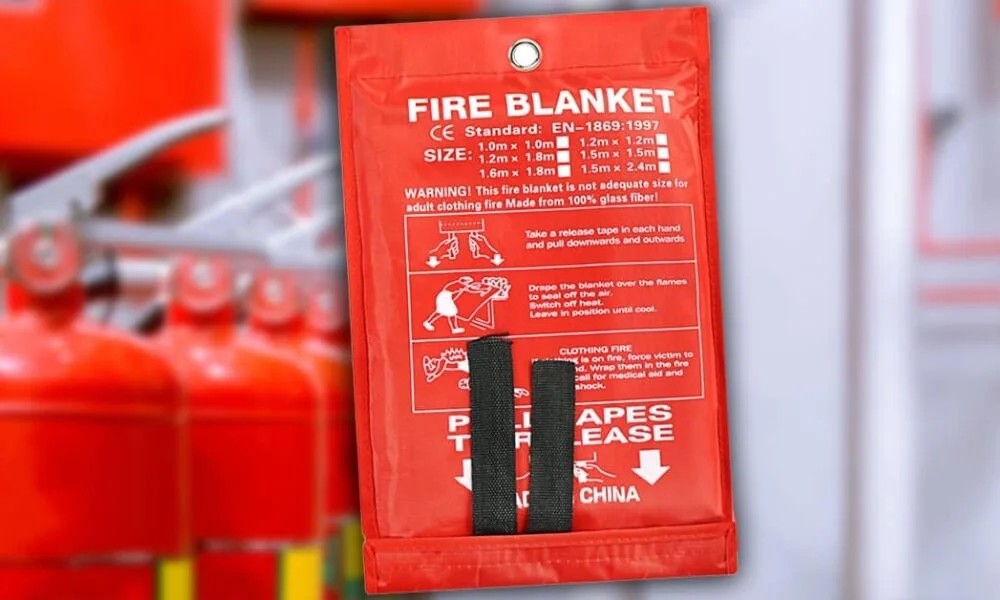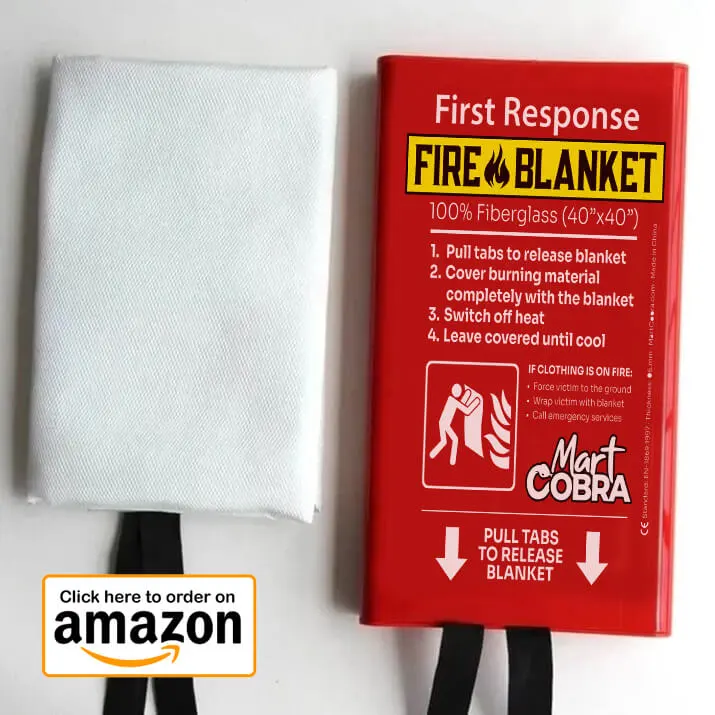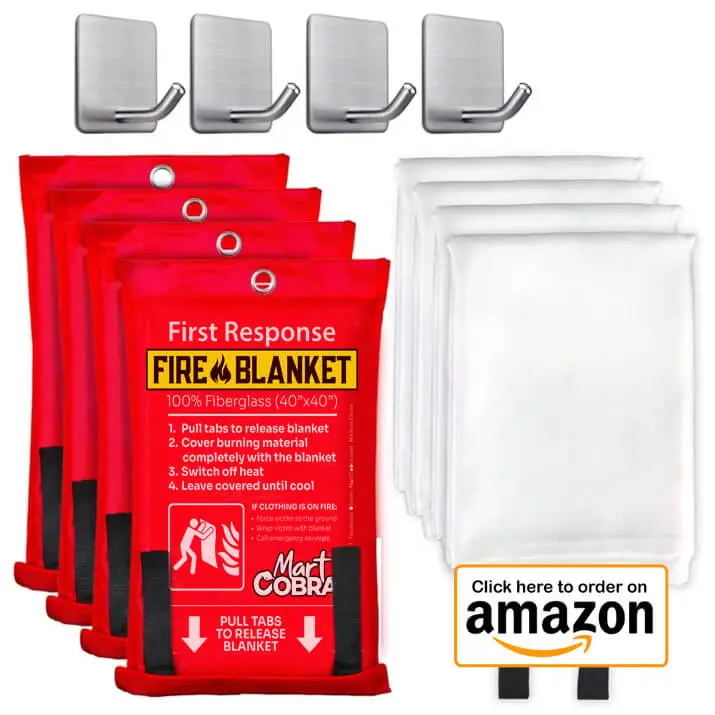A fire blanket is a simple yet essential fire safety tool designed to smother small, contained fires by cutting off their oxygen supply. Made from fire-resistant materials like fiberglass or treated wool, fire blankets are easy to use and highly effective in emergencies, particularly in kitchens, workplaces, and industrial settings.
Whether used to extinguish cooking oil fires or protect individuals whose clothes have caught fire, fire blankets offer quick, reliable protection without the need for extensive training. In this blog, we’ll explore what fire blankets are, the different types available, their uses, and how they work to keep you safe during emergencies.
What is a Fire Blanket?
A fire blanket is a sheet of woven, fire-resistant material, typically made from fibreglass or treated wool, that is used to smother a fire. By covering a fire with the blanket, it cuts off the oxygen supply, effectively extinguishing the flames. These blankets are stored in quick-release containers or pouches, ensuring easy access during emergencies.
Fire blankets can withstand high temperatures, often up to 650°C to 900°C, making them suitable for small, high-risk fires such as those involving cooking oils and clothing fires.
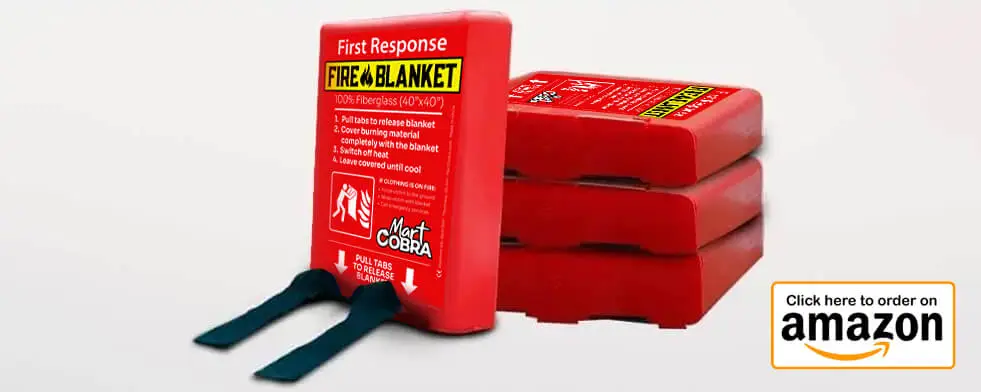
How Do Fire Blankets Work?
A fire blanket is a simple, yet highly effective tool for extinguishing small, contained fires. Its primary function is to smother the flames by cutting off the oxygen supply, which is essential for fire to sustain itself. Below is a detailed breakdown of how fire blankets work and how they ensure fire safety.
Understanding the Fire Triangle: Breaking the Chain
To understand how a fire blanket extinguishes flames, it’s important to know about the fire triangle. The three elements needed for a fire are:
- Heat
- Fuel
- Oxygen
By placing a fire blanket over a fire, it removes the oxygen element from the fire triangle. This action starves the flames of oxygen, halting the combustion process and extinguishing the fire.
Step-by-Step Process: How a Fire Blanket Works
A fire blanket works by cutting off the oxygen supply to a fire, effectively smothering the flames. Its heat-resistant material ensures safe handling while containing small, contained fires. Below is a detailed explanation of how fire blankets function to stop fires and protect people in emergencies.
Smothering the Flames:
- When the blanket is laid over the fire, it blocks airflow, preventing oxygen from reaching the flames. This action causes the fire to suffocate and go out.
Heat Resistance and Insulation:
- Fire blankets are made from fire-resistant materials like fibreglass or wool treated with flame-retardant fluid. These materials can withstand high temperatures (up to 900°C), protecting the user from burns when placing the blanket over the fire.
Safe Handling with Insulated Hands:
- When properly used, the blanket’s edges are folded over the user’s hands to shield them from heat while they approach the fire. This allows them to safely place the blanket over the fire without getting burned.
Preventing Reignition:
- After the fire is smothered, the blanket remains in place to allow the heat to dissipate. Leaving the blanket on the fire for 15-30 minutes ensures that no residual heat or embers reignite the flames.
Wrapping Around People with Clothing Fires:
- In cases where clothing catches fire, the fire blanket is used to wrap around the person, cutting off oxygen to the flames. The individual should also stop, drop, and roll to further extinguish the fire.
Key Features That Make Fire Blankets Effective
- Non-Flammable Materials: Fire blankets are typically made from fibreglass, wool, or cotton treated with flame-retardant chemicals, ensuring they won’t catch fire themselves.
- Quick-Release Design: Fire blankets are stored in easy-to-access containers that allow them to be deployed quickly during emergencies.
- Heat Resistance: Fire blankets can withstand temperatures ranging from 550°C to 900°C, depending on the material, making them suitable for kitchen fires and industrial use.
How Fire Blankets Compare to Fire Extinguishers
Fire blankets are particularly effective for small, contained fires, such as cooking oil fires (Class F), where water or fire extinguishers could worsen the situation. For example:
- Water extinguishers are ineffective on grease fires, but a fire blanket can smother the flames safely.
- Fire extinguishers are more suitable for large fires or fires involving electrical equipment, but fire blankets are safer and simpler for untrained individuals.
Situations Where Fire Blankets Are Most Useful
- Kitchen Fires: Ideal for smothering oil or grease fires on stovetops.
- Clothing Fires: Can be wrapped around a person whose clothes have caught fire.
- Laboratory and Industrial Settings: Useful for small chemical or equipment fires.
- Rescue Operations: Fire blankets can insulate individuals from heat during an escape or evacuation.
Fire blankets are a simple, effective, and essential fire safety tool. They work by cutting off oxygen from the fire, insulating against heat, and preventing the flames from spreading. Their ease of use makes them ideal for households, kitchens, laboratories, and industrial spaces. For small fires, a fire blanket can provide immediate relief and protection, often proving to be more effective than a fire extinguisher in certain scenarios.
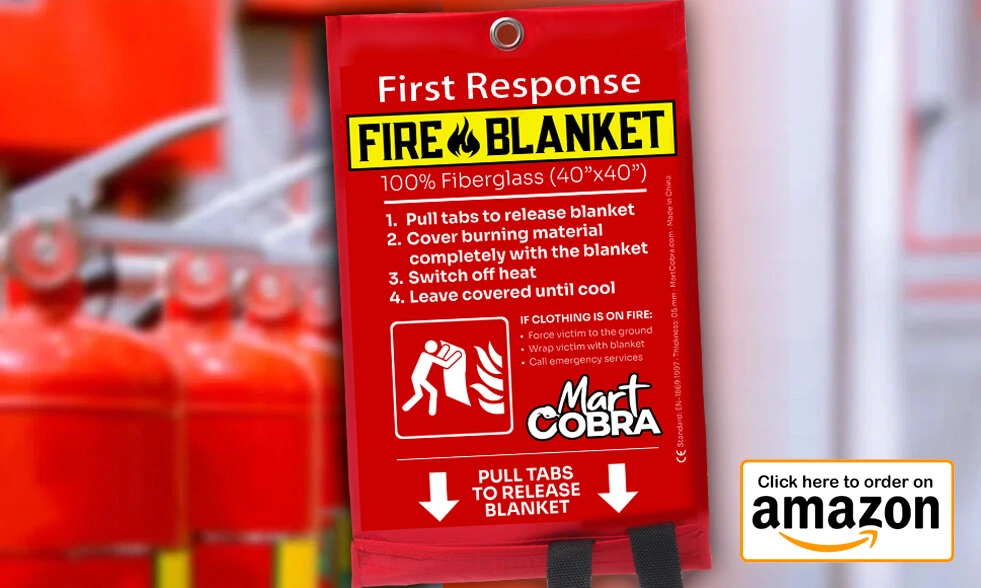
Types of Fire Blankets
There are several types of fire blankets, each crafted for specific environments and fire risks. Understanding the differences between these blankets ensures you choose the right one for your needs—whether it’s for a home kitchen, a laboratory, or an industrial workspace. Below is a detailed breakdown of the common types of fire blankets, their materials, uses, and advantages.
1. Fiberglass Fire Blankets
- Material: Woven fiberglass threads
- Properties: Fiberglass is naturally fire-resistant and can withstand high temperatures without burning.
- Usage: Suitable for household fires, including kitchen fires and electrical fires.
- Advantages:
- Lightweight and easy to store
- Provides excellent protection against burns when used properly
- Ideal for a variety of situations, including homes and industrial settings
Why Choose This Type?
Fiberglass fire blankets are the most popular choice for both home and commercial use because of their versatility, durability, and ability to tackle common fire hazards like pan fires or appliance malfunctions.
2. Wool Fire Blankets with Flame-retardant Fluid
- Material: Wool soaked in flame-retardant fluid
- Properties: The flame-retardant fluid enhances the wool’s resistance to fire and heat.
- Usage: Often used in laboratories and environments with chemical fire risks.
- Advantages:
- Can be used to drape over a person to protect against flames
- Effective in containing fires involving chemicals
- Offers good insulation against heat
Why Choose This Type?
Wool fire blankets are ideal for personal protection in settings where people may need to escape or be shielded from heat, such as in a lab or a high-risk facility.
3. Fire-resistant Cotton Blankets
- Material: Cotton treated with fire-resistant chemicals
- Properties: While less effective than fiberglass, fire-resistant cotton offers moderate fire protection and is more comfortable against the skin.
- Usage: Best suited for low-risk situations or as an escape aid during a fire emergency.
- Advantages:
- Comfortable to wear or use for shielding from heat
- Can be wrapped around people for protection during evacuation
Why Choose This Type?
These blankets are practical for minor heat shielding and evacuation scenarios where direct flame contact is unlikely. They offer a comfortable alternative for personal use but may not withstand intense fires.
4. Industrial Fire Blankets
- Material: Often made from a blend of fiberglass and synthetic compounds for added durability.
- Properties: Engineered to endure higher temperatures and more intense fire conditions.
- Usage: Primarily used in industrial settings with large machinery, furnaces, or other fire-prone equipment.
- Advantages:
- Larger in size to cover machinery or large workstations
- Provides enhanced protection for severe fire risks
- Resistant to wear and tear, making it suitable for harsh environments
Why Choose This Type?
Industrial fire blankets are essential in factories and workshops where the risk of high-temperature or large-scale fires is present. Their larger size and robust materials offer protection that smaller, household blankets cannot provide.
Which Fire Blanket Is Right for You?
The type of fire blanket you choose depends on the environment and potential fire risks. For example:
- Fiberglass fire blankets are ideal for kitchens and homes because they are lightweight and effective.
- Wool fire blankets work well in chemical labs where personal protection is crucial.
- Cotton fire blankets provide comfort during evacuation but are better for low-risk scenarios.
- Industrial fire blankets offer superior protection in high-temperature environments, such as manufacturing plants.
Selecting the right fire blanket ensures you have reliable protection tailored to your needs, enhancing safety in emergencies.
When to Use a Fire Blanket
Fire blankets are suitable for small, contained fires. Below are common scenarios where they are most effective:
- Kitchen Fires: For extinguishing cooking oil fires (Class F) on stovetops or fryers
- Clothing Fires: To wrap around a person whose clothes have caught fire, following the Stop, Drop, and Roll technique
- Small Industrial Fires: Used in laboratories or workshops to extinguish minor chemical spills or equipment fires
- Escape and Rescue: Wrapped around individuals to provide insulation when passing through flames during evacuation
Important: If the fire is too large or spreads quickly, evacuate immediately and call the fire department.
How to Use a Fire Blanket Effectively
Using a fire blanket correctly ensures your safety and the complete extinguishing of a fire. While it may seem straightforward, following a precise sequence of steps is crucial to effectively handle fire emergencies. Here is a detailed, step-by-step guide to using a fire blanket.
Step 1: Pull the Fire Blanket from its Storage Pouch
Why: Fire blankets are kept in quick-release containers or pouches for easy access during emergencies.
How:
- Grasp the two tabs or straps at the bottom of the container.
- Pull them down sharply to release the blanket.
- Ensure the blanket is unfolded and ready for use.
Step 2: Protect Your Hands
Why: Shielding your hands from heat and flames prevents burns while placing the blanket over the fire.
How:
- Wrap the top corners or edges of the blanket around your hands.
- This will create a protective layer between your skin and the heat.
Step 3: Approach the Fire Safely
Why: Caution is essential to avoid injury or worsening the situation.
How:
- Hold the blanket in front of you as a shield to protect your face and body.
- Approach the fire slowly and carefully.
- Avoid throwing the blanket from a distance—this could allow flames to rise around the blanket.
- Lay the blanket gently over the fire, starting from the near edge and moving forward to prevent flames from spreading toward you.
Step 4: Place the Blanket Over the Fire
Why: The fire blanket works by smothering the flames and cutting off the oxygen supply, which is essential for combustion.
How:
- Ensure the blanket completely covers the fire, creating a tight seal around the edges.
- For cooking fires, make sure the blanket touches the pan or surface to prevent oxygen from reaching the flames.
Step 5: Turn Off the Heat Source (If Safe to Do So)
Why: Cutting off the heat source ensures the fire is fully extinguished and prevents reignition.
How:
- If the fire started on a stove, oven, or appliance, turn off the power or gas supply.
- If it is not safe to do so immediately, wait until the fire is under control before switching it off.
Step 6: Leave the Blanket in Place
Why: Prematurely removing the blanket can reintroduce oxygen, leading to reignition.
How:
- Keep the blanket on the fire for at least 15-30 minutes.
- Ensure the fire area is completely cool before removing the blanket.
- In some cases, it’s safer to leave the blanket in place for up to an hour to prevent reignition.
Step 7: Call Emergency Services
Why: Even if the fire appears extinguished, lingering heat or embers could reignite the flames.
How:
- Dial emergency services to report the fire, ensuring the area is thoroughly inspected and safe.
- This step is essential for fires that may have spread beyond what the blanket can contain.
Using a Fire Blanket for Clothing Fires
Why: Fire blankets are also effective in extinguishing clothing fires and protecting individuals.
How:
- Wrap the blanket around the person whose clothes are on fire, covering them completely to smother the flames.
- Instruct the person to stop, drop, and roll to extinguish any remaining flames.
- Once the flames are out, seek immediate medical assistance for any burns or injuries.
Final Tips for Effective Use
- Practice Regular Drills: Familiarize yourself with using the fire blanket to react quickly during real emergencies.
- Keep the Blanket Accessible: Store it in a visible, easy-to-reach location—ideally near an exit or kitchen entrance.
- Replace After Use: Fire blankets are single-use items. Dispose of the blanket after deployment and replace it immediately.
Using a fire blanket correctly can prevent small fires from escalating into major emergencies. By following these steps—accessing the blanket, protecting your hands, safely covering the fire, and leaving the blanket in place—you can ensure both your safety and the effective extinguishing of the fire. Remember, always call emergency services, even if the fire appears under control. Preparedness and proper use of a fire blanket can save lives and minimize property damage during fire emergencies.
Maintenance and Replacement of Fire Blankets
Keeping a fire blanket in top condition ensures it will be effective when needed. Below is a practical guide to inspecting, maintaining, and replacing your fire blanket, along with some essential safety tips.
Regular Inspections
Checking your fire blanket every now and then is important to make sure it stays in good shape. Here’s how:
- Inspect the blanket and container: Look for any signs of wear, tears, or contamination (like grease or dust).
- Test the quick-release mechanism: Pull the tabs or straps to confirm they release the blanket smoothly.
- Check for moisture exposure: A damp fire blanket may not work properly, so store it in a dry place.
Replacement After Use
Fire blankets are single-use tools—once used, they must be replaced. Even if the fire was small, the blanket may have lost its effectiveness.
- Dispose of used blankets properly: Don’t try to refold or reuse them.
- Replace immediately: Always have a replacement ready to ensure you’re prepared for the next emergency.
No Expiry Date
While most fire blankets don’t have an official expiration date, it’s still recommended to replace them every seven years. Even if the blanket looks fine, a new one ensures reliability when needed.
Fire Blanket Safety Tips
Fire blankets are essential safety tools, but using and maintaining them correctly is key to ensuring they are effective during emergencies. Below are practical safety tips to keep in mind when storing, using, and pairing fire blankets with other fire safety equipment.
1. Store Properly
Why: Quick access is crucial in an emergency, as every second counts.
How:
- Place the blanket near the kitchen entrance or other high-risk areas, but not directly near a stove or heat source where a fire could block your access.
- Ensure it is mounted in an easy-to-reach location, with clear signage if used in public or commercial spaces.
- Avoid storing it in a cupboard or drawer where it could be overlooked or obstructed during an emergency.
2. Pair with Fire Extinguishers
Why: While fire blankets are excellent for small, contained fires, they aren’t suitable for all types of fires.
How:
- Use a fire blanket alongside a fire extinguisher to provide comprehensive fire safety.
- In kitchens, pair the blanket with a wet chemical extinguisher for Class F fires (cooking oils).
- In workshops or industrial spaces, have appropriate extinguishers (like CO₂ or foam) available for electrical or chemical fires.
3. Avoid Using on Electrical Fires or Hazardous Materials
Why: Fire blankets are not designed to handle every fire type, especially those involving flammable gases or electricity.
How:
- Do not use a fire blanket on electrical fires, as it might not fully contain the fire, and the user could still be at risk. Use a CO₂ extinguisher instead.
- Avoid using it on fires involving flammable gases or metals. Such fires require specialized extinguishers designed to handle these materials.
4. Conduct Regular Inspections and Replace After Use
Why: A damaged or previously used blanket may fail to smother a fire effectively.
How:
- Check the blanket and its container regularly for tears, contamination, or damage to the quick-release tabs.
- If the blanket has been used, dispose of it immediately and replace it with a new one. Fire blankets are single-use items and should not be reused.
- Replace older blankets every 7 years for reliability, even if they haven’t been used.
Following these fire blanket safety tips ensures you are prepared to handle emergencies safely and effectively. Proper storage and regular maintenance are essential to quick deployment, while pairing the blanket with the right fire extinguisher ensures you’re ready to tackle different fire types. Understanding what types of fires fire blankets can—and cannot—handle will help you make smarter, safer decisions during emergencies.
Conclusion
A fire blanket is a valuable safety tool that can make a critical difference in emergencies by quickly and effectively smothering small fires. Its simplicity, versatility, and ease of use make it ideal for homes, kitchens, workplaces, and industrial environments. Whether you need to extinguish a cooking oil fire, shield yourself during evacuation, or assist someone with a clothing fire, a fire blanket provides an accessible and reliable first line of defense. However, it’s essential to store it correctly, pair it with the appropriate fire extinguisher, and understand its limitations.
Regular inspections and timely replacement ensure your fire blanket is always ready when needed. With the right knowledge and preparation, fire blankets can help protect lives and property, offering peace of mind in case of an unexpected fire emergency.

